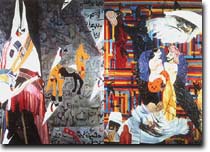Asianart.com | Contemporary Art and Identity | Exhibitions
![]()
by Dr. Andrew L. Cohen
Department of Art, University of Central Arkansas.
The social articulation of difference, from the minority perspective, is a complex, on-going negotiation that seeks to authorize cultural hybridities that emerge in moments of historical transformation. The 'right' to signify from the periphery of authorized power and privilege does not depend on the persistence of tradition; . . . Homi Bhabha, The Location of Culture, p.2
 The
discursive history of North American - South Asian art is one of stereotyping
and disparity. Shaped by multiple, overlapping, and usually hierarchic,
notions that impose Western modernism and contemporary art as the framing
and defining systems upon which to conceptualize South Asian art, the
visual arts discourse is burdened by either having to explain how South
Asian art constitutes itself as Western equivalent or by apologists explaining
South Asia's uniqueness. If unique, then 'Indianness' and tradition becomes
the focus; if modern/contemporary then the insidious, and at this point
truly banal, Western analogies frame artistic polemics. Usually it is
not a clear either/ or situation, and some combination of alternating
views coalesce. How to remove the 'West,'- by that I mean, how to deflate
or even neutralize the term 'West' as a dominant value- to see non-Western
art? How to remove ethnicity and authenticity as value criteria? As agency
replaces dated essentializing of geography and locality, peoples and cultures,
arts and styles, discourse opens and how things (art) change, or what
Homi Bhabha refers to as the "in-between" space, emerges.
The
discursive history of North American - South Asian art is one of stereotyping
and disparity. Shaped by multiple, overlapping, and usually hierarchic,
notions that impose Western modernism and contemporary art as the framing
and defining systems upon which to conceptualize South Asian art, the
visual arts discourse is burdened by either having to explain how South
Asian art constitutes itself as Western equivalent or by apologists explaining
South Asia's uniqueness. If unique, then 'Indianness' and tradition becomes
the focus; if modern/contemporary then the insidious, and at this point
truly banal, Western analogies frame artistic polemics. Usually it is
not a clear either/ or situation, and some combination of alternating
views coalesce. How to remove the 'West,'- by that I mean, how to deflate
or even neutralize the term 'West' as a dominant value- to see non-Western
art? How to remove ethnicity and authenticity as value criteria? As agency
replaces dated essentializing of geography and locality, peoples and cultures,
arts and styles, discourse opens and how things (art) change, or what
Homi Bhabha refers to as the "in-between" space, emerges.
During the past few
decades contemporary South Asian art has been highlighted in numerous
international and prestigious forums. Those concerned with the art market
will be quick to remind us of the successful Sotheby and Christie's auctions
of Indian modern/contemporary art, or of the prolific spread of exclusive
galleries of late. In North America, a pivotal exhibition at the Asia
Society "Contemporary Art in Asia: Traditions/Tensions" during
1996 thundered onto the New York art scene (and onto Vancouver, B.C.),
and for some critical viewers it became apparent that art is elsewhere
too.
 While
many critics in the West remain contentedly oblivious to these elsewheres,
globalization is collapsing the cultural central/peripheral spaces. Now
unencumbered by fixity of place, creativity and visual culture rapidly
transmits and metamorphoses. In North America, vital and productive South
Asian diaspora artists are making bold visuals addressing hybridity. Diaspora
art is a sticky subject, but one I think needs greater attention. Those
living in diaspora, do they retain their Indianness? Does one lose Indianness
after a certain time lapse, or after a generation abroad? This, of course,
is essentialized thinking and inappropriate viewing. It is the debunking
of ethnic/religious/gender/sexual stereotypes, with all its ugly prejudices,
or romanticized ideals, that artists in this exhibition address. Hybrid
identities and ones self examination is a personal matter, and topic of
art universally; subject is self. Artists in this exhibition explore their
personal journey in our globalized, hybridized 21st century. It is within
the rupture of newness, or 'in-between' places, and the dialectics of
global and localized that we can view this contemporary art.
While
many critics in the West remain contentedly oblivious to these elsewheres,
globalization is collapsing the cultural central/peripheral spaces. Now
unencumbered by fixity of place, creativity and visual culture rapidly
transmits and metamorphoses. In North America, vital and productive South
Asian diaspora artists are making bold visuals addressing hybridity. Diaspora
art is a sticky subject, but one I think needs greater attention. Those
living in diaspora, do they retain their Indianness? Does one lose Indianness
after a certain time lapse, or after a generation abroad? This, of course,
is essentialized thinking and inappropriate viewing. It is the debunking
of ethnic/religious/gender/sexual stereotypes, with all its ugly prejudices,
or romanticized ideals, that artists in this exhibition address. Hybrid
identities and ones self examination is a personal matter, and topic of
art universally; subject is self. Artists in this exhibition explore their
personal journey in our globalized, hybridized 21st century. It is within
the rupture of newness, or 'in-between' places, and the dialectics of
global and localized that we can view this contemporary art.